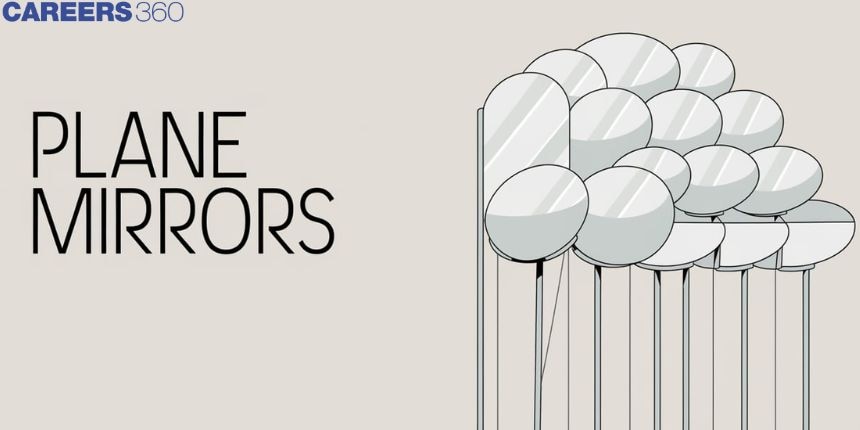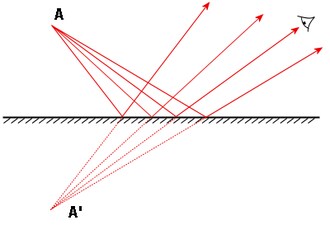Plane Mirrors - Definition, Image Formation, Applications, Uses, FAQs
Plane mirrors are fairly common in our daily lives. Even if the typical person is unfamiliar with this scientific phrase, they may easily compare it to ordinary mirrors that are polished on one side with mercury so that light falling on them can be reflected. In this article, we will discuss what is plane mirrors, the characteristics of plane mirrors, image formation by plane mirrors, laws of reflection, plane mirror ray diagram, characteristics of image formed by plane mirrors, and plane mirror examples and uses.
JEE Main/NEET 2027: Physics Important Formulas for Class 10
NEET 2025: Mock Test Series | Syllabus | High Scoring Topics | PYQs
JEE Main: Study Materials | High Scoring Topics | Preparation Guide
JEE Main: Syllabus | Sample Papers | Mock Tests | PYQs
- What is Plane Mirror?
- Characteristics of Plane Mirror
- Image Formation by Plane Mirror
- Virtual Image Of Plane Mirrors
- Laws of Reflection
- Characteristics of Image Formed by Plane Mirrors
- Plane Mirror Examples And Uses

What is Plane Mirror?
Plane mirror definition: A plane mirror is described as a mirror having a flat surface and no inward or outward curve. They may easily reflect light in a variety of directions, resulting in refraction, absorption, or reflection on a plane mirror. In plane mirrors, at least two rays are required to build a picture of the object by examining the endpoints of the two light rays taken. The plane mirror can be polished with a variety of materials and used for a variety of purposes, but regardless of the material used in its construction, all mirrors work the same way.
Regardless of whether the image is real or virtual, the angle at which the ray is reflected by a plane mirror is equal to the angle at which the ray of light is incident, where the angle of incidence is the angle image formed by a plane mirror at an imaginary surface normal to the mirror (which is perpendicular to the surface) at the point of incidence. The angle created at the point between the contact of the reflected ray and the surface normal to the plane mirror is known as the angle of reflection.
Characteristics of Plane Mirror
- The image formed by a plane mirror appears behind the screen hence it cannot be projected.
- The image is upright and oriented the same way as the object and both sides are reversed.
- The size of the image is the same as the object, unlike a convex mirror.
- The distance from the mirror to both the image and the object is equal.
$$
d_{\text {image }}=d_{\text {object }}
$$
- Laws of reflection are obeyed.
- A plane mirror provides a limited field of view
Image Formation by Plane Mirror
A person must be in the line of sight of the mirror to see any image in the mirror. When a person is in the line of sight of the mirror, the reflected ray reaches that person's eye, through which anyone can see the image of the object if they are in the line of sight of the mirror because light moves in a straight line. The fundamental properties of a plane mirror are that the objects' reflections produce a virtual image with the same magnification, size, and distance as the object itself.
The picture of the object is determined by the geometrical line that a person sees in the mirror, yet the image of the object can be seen from any line of sight as long as the person's eye is in line with the mirror. The picture created is on the opposite side of the mirror, with the image's distance from the surface equal to the object's distance from the surface, which explains why a person can see exactly what is behind him.
Virtual Image Of Plane Mirrors
Plane mirrors are used to create virtual images of items because they are polished on one side, allowing the reflection of the object to strike the mirror and be mirrored in the direction of the observer's eye. As a result, the observer sees the image at the same distance from the mirror as the object. The magnification, size, and distance of the item are all the same in the picture generated by the flat mirror. These virtual plane mirror pictures are not produced on the screen in the same way that a genuine image is.
|
Related Topics, |
Laws of Reflection
Two general reflection laws can be stated as follows:
- The incidence angle (i) is always equal to the reflection angle (r).
$$
\theta_i=\theta_r
$$
- The incident ray, the reflected ray, and the normal at the point of incidence are all in the same plane.
A plane mirror ray diagram: For the spectator, the incident light rays from the item produce an apparent mirror image.

Characteristics of Image Formed by Plane Mirrors
Characteristics of the plane mirror:
1. The plane images created by plane mirrors are always virtual.
2. The plane images created by flat mirrors are erect/ upright and of equal size to the item.
3. The plane mirror image creates an image that is the same size as the thing.
4. The plan mirror creates an image with the same magnification as the object.
5. One of the plane mirror's most distinguishing features is that the image it produces is inverted; for plane mirror examples, if you lift your left hand, the plane mirror's image will show your right hand moving upwards.
Plane Mirror Examples And Uses
Without a doubt, the invention of mirrors is the most significant contribution to physics. For several reasons, almost everyone else uses mirrors in their daily lives. We also know that plane mirrors are primarily utilized to see an object's reflection. Plane mirrors can be found in periscopes and kaleidoscopes, cars, shaving mirrors, dentists' mirrors, torch lights, solar cookers, and security-related applications.
Periscopes and Kaleidoscopes use plane mirrors:
Plane mirrors are commonly employed in the manufacture of kaleidoscopes, which are popular among youngsters, and periscopes, which are used solely in submarines. The plane mirror used in submarine periscopes reflects the plain images of all the ships present on the water's surface. Kaleidoscopes employ plane mirrors colored red glass to reflect a variety of colorful patterns.
Torch lights use plane mirrors:
Plane mirrors are commonly used in flashlights and torch lights to reflect light beams, and they are also employed in overhead projectors for the same purpose. Plane mirrors in torchlight can be utilized for finding or looking for things at night and in dark regions with such purposes and applications.
Plane mirrors are used for security and safety:
Plane mirrors are commonly used to locate bombs beneath vehicles. They're also used at shops and stores to keep an eye on consumers and avoid robberies. Mirrors are utilized even on blind corners on busy roads to view vehicles approaching from the opposite direction.
Other examples are:
- Terrestrial telescope
- Decorative mirrors
- Laser reflectors
Also read:
Frequently Asked Questions (FAQs)
Plane mirrors are commonly used to locate bombs beneath vehicles. They're also used at shops and stores to keep an eye on consumers and avoid robberies. Mirrors are utilised even on blind corners on busy roads to view vehicles approaching from the opposite direction.
Plane mirrors are the only type of mirror that always produces a virtual, erect, and similarly sized picture from a real thing. Virtual objects, on the other hand, produce genuine visuals. A plane mirror's focal length is infinity, and its optical power is 0.
Solar cookers make use of them.
- They're also utilized to make periscopes, which are employed on submarines.
- They're also used to build kaleidoscopes, which are toys that create lovely patterns.
- They're also found in a wide range of scientific devices.
The image is considered to be real and inverted when it is on the same side of the mirror as the item and the image distance is positive. The image of the object is considered to be virtual and upright when it is behind the mirror and the image distance is negative.
If you're looking for an image created by a flat mirror, your picture will be the same size as you are. The angle at which light rays strike a planar mirror is equal to the angle at which they are reflected.
Also Read
05 Feb'25 04:41 PM
30 Nov'24 01:19 PM
29 Nov'24 05:26 PM
29 Nov'24 02:40 PM
29 Nov'24 01:21 PM
28 Nov'24 04:42 PM
28 Nov'24 01:26 PM
28 Nov'24 01:21 PM
26 Nov'24 03:50 PM
22 Nov'24 01:31 PM
